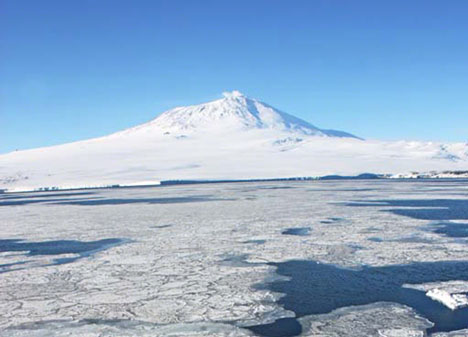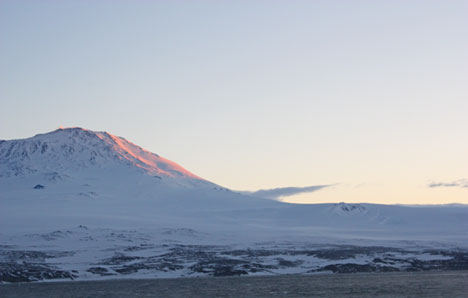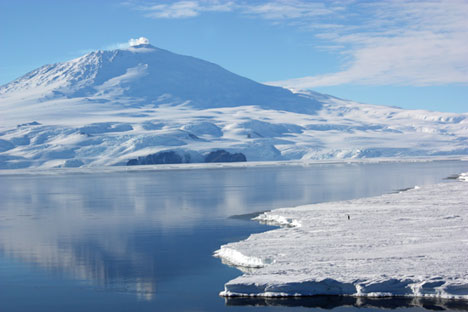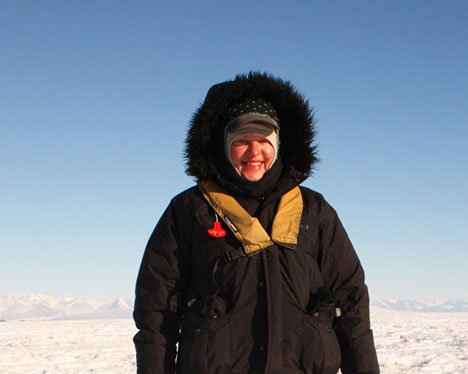
© Donna and Steve O'Meara
This guest post was written by Donna O'Meara, an award-winning writer and photographer living in Hawaii, who has photos currently on view in
"Extreme Exposure" at The Annenberg Space for PhotographyI held my breath and clanked up the metal gangplank of
The Spirit of Enderby, a privately leased Russian icebreaker that would be my new home for the next month. Following "in the footsteps of Scott and Shackleton," Enderby left port from Invercargill, New Zealand, bound for
Mount Erebus on
Ross Island in Antarctica.
The journey is only possible for about six weeks each Austral Summer -- January and February in the Southern Hemisphere -- when temperatures allow the ice to melt. For four weeks, we would rock and roll across the the Southern Ocean, the most dangerous and damned patch of water on Earth, to cross the Ross Sea and reach the base of the towering 12,400-foot high mountain.
Volcanoes Remain Mysterious, Even to ScientistsVolcanoes are Mother Nature's weapons of mass destruction. Earth is freckled with more than 1,500 dangerous volcanoes, and we still know very little about them.

© Donna and Steve O'Meara
Currently, more than 10 million people live on unmonitored, deadly volcanoes all over the world. Both my husband
Stephen and I are volcano researchers, photographers and authors.
For the past 25 years, a day at work has often meant climbing into an active volcano wearing a gas mask, hard hat, and fire-resistant body suit.
We have investigated and photographed nearly 100 of the world's volcanoes, hoping to learn more about how they work and help save people's lives; we use our photographs, books and videos to educate people about the dangers volcanoes pose. We have dodged basketball-sized lava bombs in Stromboli, Italy; hiked the scalding slopes of the Galapagos Islands' volcanoes; and raced through clouds of scalding steam and poisonous gas on Costa Rica's Poas volcano.

© Donna and Steve O'Meara
When I learned about Mount Erebus, an ice-covered volcano with a hot molten lava lake in its summit caldera, I just had to photograph it. Perhaps it held some ancient secrets?
The Journey to Mount Erebus is Not For the Faint of HeartAs Enderby sailed out of Foveaux Strait into open ocean, she pitched, tilted, plunged and keeled over so steeply that I slid across the wet deck towards the cold sea.
I held the railing tight and grabbed hand-over-fist sideways, to get back inside the ship. I eventually found my sea legs and got used to the constant lunging, dipping and surging of the ship, although I was covered with bruises from banging into things.
We had to crush and smash through all kinds of frozen obstacles - pancake ice, fast ice, frazzle ice and sea ice - the trip is so rough that even the berths were equipped with their own seat belts.

© Donna and Steve O'Meara
During our second week at sea we encountered a raging storm.
Giant waves and ice chunks slammed into the bow. I tied myself to my berth with my sheets, but things didn't get smoother.
On February 23, 2009, Enderby arrived at Erebus. I was greeted by the mesmerizing orange dawn light illuminating Erebus' white flanks.
Inspiration Gleaned From Antarctica's Wild, Remote FrontierWeeks alone on the ice in Antarctica, the most remote wild frontier left on Earth, gave me the gift of divine inspiration for my photography.
Our animal instinct for survival surfaces in the face of such remoteness and harsh beauty. We no longer worry. We survive. I wanted to test myself, so I brought only one camera and one lens, and I allowed myself only one or two images per day.
To keep my camera batteries warm I duct-taped them to the skin under my collar bone, which I reached by unzipping eight layers of down, fleece and polypropylene (think scuba suit). It worked. The magical spell the ice cast on me will be a part of my translucent soul for eternity. There will always be a part of my heart that shimmers with the luminosity, transparency and brilliance of the ice.
Thank you, Mt. Erebus. Thank you, cold. Thank you, ice. Thank you, wind. Thank you, solitude. Thank you, wild Antarctica.
We are still examining the Mt. Erebus images for any clues that might unravel the mysteries volcanoes hold. I hope Antarctica will always remain a protected, perfect, frozen wonderland, where the fiercest winds blow, where the most frigid temperatures bite, where volcanoes smothered in ice ooze hot lava, and where men and women follow their wildest dreams of adventure.
Donna O'Meara is an award winning writer/photographer living in Hawaii. She is currently finishing FIRE & ICE,
a book about her adventure to Mt. Erebus. "Extreme Exposure" at The Annenberg Space for Photography is the first public showing of the Mt. Erebus volcano images.
Reader Comments
to our Newsletter